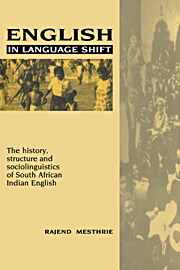
-
Select format
-
- Publisher:
- Cambridge University Press
- Publication date:
- December 2009
- January 1993
- ISBN:
- 9780511597893
- 9780521026499
- Dimensions:
- Weight & Pages:
- Dimensions:
- (228 x 152 mm)
- Weight & Pages:
- 0.396kg, 276 Pages
- Subjects:
- Sociolinguistics, Language and Linguistics
You may already have access via personal or institutional login- Subjects:
- Sociolinguistics, Language and Linguistics
Book description
Rajend Mesthrie examines the rise of a new variety of English among Indian migrant workers indentured on the plantations of Natal in South Africa. Considering the historical background to, and linguistic consequences of, language shift in an immigrant context, he draws significant parallels between second language acquisition and the processes of pidginization and creolization. In particular, he analyses universals of second language acquisition and the role of transfer from the Indic and Dravidian substrate languages. English in Language Shift observes the acquisition of language in its social setting, often outside the classroom. Its linguistic focus is on the distinctive syntax of South African Indian English, with respect to word order and clause structures; and it contains descriptions of lexis, phonetics and morphology, in terms of social variation. South African Indian English is compared with other dialects within South Africa, with English in India, and with Englishes generally.
Reviews
'A fascinating and very well-documented account of the evolution and development of South African Indian English since the Indian indentured labourers were brought into South Africa, beginning in the 1860s.'
Gillian Sankoff - University of Pennsylvania
'A most impressive piece of work.'
J. M. Coetzee
Contents
Metrics
Full text views
Full text views help Loading metrics...
Loading metrics...
* Views captured on Cambridge Core between #date#. This data will be updated every 24 hours.
Usage data cannot currently be displayed.
Accessibility standard: Unknown
Why this information is here
This section outlines the accessibility features of this content - including support for screen readers, full keyboard navigation and high-contrast display options. This may not be relevant for you.
Accessibility Information
Accessibility compliance for the PDF of this book is currently unknown and may be updated in the future.


